An information security policy template is a document that provides a framework for organizations to develop and implement their own information security policies. It contains a set of guidelines that help organizations protect their information assets from unauthorized access, use, disclosure, disruption, modification, or destruction. Information security policies are essential for all organizations that handle sensitive information, such as customer data, financial information, or trade secrets.
A sample information security policy template can help organizations get started with developing their own policies. It can provide guidance on the key elements that should be included in a policy, such as the scope of the policy, the roles and responsibilities of different individuals and departments, the security measures that should be implemented, and the procedures for responding to security incidents.
Elements of a strong Information Security Policy
A strong information security policy should include the following elements:
- Scope: The scope of the policy should define the boundaries to which the policy applies. This includes the types of information that are covered by the policy, the locations where the information is stored or processed, and the individuals who are subject to the policy.
- Roles and Responsibilities: The policy should define the roles and responsibilities of different individuals and departments in the organization with respect to information security. This includes the responsibility for developing and implementing security measures, the responsibility for monitoring and enforcing security policies, and the responsibility for responding to security incidents.
- Security Measures: The policy should specify the security measures that should be implemented to protect information assets. This includes measures to protect against unauthorized access, use, disclosure, disruption, modification, or destruction of information. The policy should also specify the procedures for implementing and monitoring these security measures.
- Incident Response: The policy should define the procedures for responding to security incidents. This includes the steps to be taken to contain the incident, to investigate the incident, and to recover from the incident.
Benefits and Implementation of information security policy
There are many benefits to implementing a strong information security policy. These benefits include:
- Protection of Information Assets: A strong information security policy helps to protect information assets from unauthorized access, use, disclosure, disruption, modification, or destruction.
- Compliance with Laws and Regulations: Many laws and regulations require organizations to implement information security policies. A strong information security policy can help organizations to comply with these laws and regulations.
- Reduced Risk of Security Incidents: A strong information security policy can help to reduce the risk of security incidents by providing a framework for organizations to identify, assess, and mitigate security risks.
- Improved Reputation: A strong information security policy can help to improve an organization’s reputation by demonstrating to customers and partners that the organization takes information security seriously.
To implement a strong information security policy, organizations should:
- Develop a Policy: The first step is to develop an information security policy that is tailored to the organization’s specific needs. This policy should be based on the elements described above.
- Communicate the Policy: Once the policy is developed, it is important to communicate it to all employees and stakeholders. This can be done through training sessions, email, or other means.
- Implement the Policy: Once the policy is communicated, it is important to implement it. This includes implementing the security measures specified in the policy and establishing procedures for responding to security incidents.
- Monitor and Enforce the Policy: Once the policy is implemented, it is important to monitor and enforce it. This includes monitoring compliance with the policy and taking action against individuals who violate the policy.
FAQs about Sample Information Security Policy Template
What is a sample information security policy template?
A sample information security policy template is a document that provides a framework for organizations to develop and implement their own information security policies. It contains a set of guidelines that help organizations protect their information assets from unauthorized access, use, disclosure, disruption, modification, or destruction.
What are the benefits of using a sample information security policy template?
The benefits of using a sample information security policy template include:
- It can help organizations to develop their own policies more quickly and easily.
- It can provide guidance on the key elements that should be included in a policy.
- It can help organizations to ensure that their policies are comprehensive and effective.
Where can I find a sample information security policy template?
There are many sources where you can find a sample information security policy template. Some of these sources include:
- The website of your state or federal government.
- The website of a professional organization, such as the Information Systems Security Association (ISSA).
- The website of a security software vendor.
